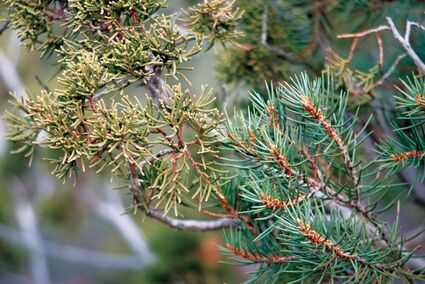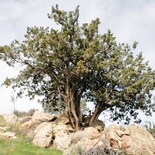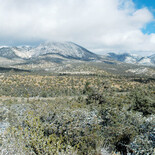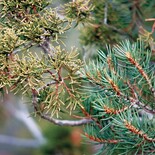The unique and unforgettable Pinyon Juniper Woodland
Land of Four Seasons
September 3, 2022

Jon Hammond
A view of Pinyon Juniper Woodland looking north in Sand Canyon. Sugarloaf Mountain is in the center background, its summit obscured by low clouds.
For most people, the initials "PJ" are an abbreviation for pajamas, but for those involved with natural resources in the West, PJ is shorthand for Pinyon Juniper Woodland, one of the most widespread plant communities across a swath of the American Southwest.
Pinyon Juniper Woodland covers an estimated one quarter of all of New Mexico, and is also found in extensively in Arizona, Nevada, Utah, Colorado and parts of California. In our area, Pinyon Juniper Woodland is found in much of Sand Canyon, the Old West Ranch and other areas on the eastern, desert-facing parts of the Tehachapi Mountains.
In different parts of its range, the Pinyon Juniper Woodland consists of different species of Pinyon Pine paired with as many as four different species of Juniper, but locally the combination is generally Single-leaf Pinyon Pine (Pinus monophylla) and California Juniper (Juniperus californicus).
Since it features two of the most drought-tolerant of conifers, the Pinyon Juniper Woodland is found in fairly arid regions where the annual precipitation averages between 10 and 15 inches a year. Temperatures in these areas tends to swing wildly over the course of a year, and with elevations that vary between 2,000 feet and nearly 7,000 feet, the Pinyon Juniper Woodland can withstand more than 100 degrees Fahrenheit on summer days and well below zero degrees Fahrenheit on very cold winter nights.
With California's prolonged drought, survival is becoming more difficult even for these extremely hardy trees, and both of them, but particularly single-leaf Pinyon Pine, have been succumbing to the combined pressures of drought, pine bark beetles, increased heat, etc. It seems likely PJ Woodlands will shrink in the next few decades.
A quick side note here on the word "conifer": this refers to any cone-bearing tree or shrub, so this is the proper term to use when you're referring to one of these plants that you can't identify. Most people just say "pine," whether they are talking about a windbreak of Arizona Cypresses, a Hollywood Juniper growing next to the garage, a White Fir or Noble Fir being used as a Christmas tree in the living room, the two giant Deodar Cedars outside Tehachapi Hospital. . . they all get called "pines."
No, they're not pines, but they are all conifers, whether they are cedars, cypresses, junipers, spruces, firs, redwoods, or even pines. So show your knowledge and accurately use the term "conifer" rather than "pine" when referring to an unknown member of this large group.
I find the Pinyon Juniper Woodland to be a fragrant and beautiful place. Neither of these trees typically gets very large (it has been referred to as a pygmy forest) with their height usually below 25 feet. Since they tend to grow in sandy or rocky soil there isn't much brush or understory plants, so it is usually fairly easy to hike or even ride a horse through the Pinyon Juniper Woodland. Both the pines and the junipers have aromatic, resinous foliage so there is a pleasant scent to these woodlands, especially after an infrequent rain.
A number of animals reside in PJ, including California Mule Deer, Coyotes, Merriam's Chipmunks, Desert Cottontails, Black-tailed Jackrabbits, Black Bear, Mountain Lion and others. Many birds also live here or visit, including California Towhee, Greater Roadrunner, Pinyon Jays, Common Ravens, California Quail and more.
The Pinyon Juniper Woodland is found in some of the most spectacular scenery in the Southwest, including areas like Grand Canyon and around notable ancient cliff dwellings, and it has been used for many centuries by Native American groups, who harvested the pine nuts and juniper berries and also utilized the wood these trees produce.
The Nuwä (Kawaiisu or Southern Paiute) word for Pinyon Pine is tüvapü, pronounced tuh-VAAP-uh, and California Juniper is wa'adabü, pronounced wah-ah-DAAB-uh.

Jon Hammond
California Juniper and single-leaf Pinyon Pine growing right together. The juniper foliage is the olive green, rounded scales on the left and the pine is the short, pointy green needles on the right.
Later settlers throughout the West made use of huge amounts of PJ wood for gold smelting, fuel and fence posts. Happily, these pressures (often unsustainable) have lessened in the past century.
While it is not as tall or imposing as other woodlands or forests, the Pinyon Juniper Woodland is a unique and lovely plant community, and we are fortunate to have some extensive stands growing in the Tehachapi Mountains.
Keep enjoying the beauty of life in the Tehachapi Mountains.
Jon Hammond is a fourth generation Kern County resident who has photographed and written about the Tehachapi Mountains for 38 years. He lives on a farm his family started in 1921, and is a speaker of Nuwä, the Tehachapi Indian language. He can be reached at tehachapimtnlover@gmail.com.







